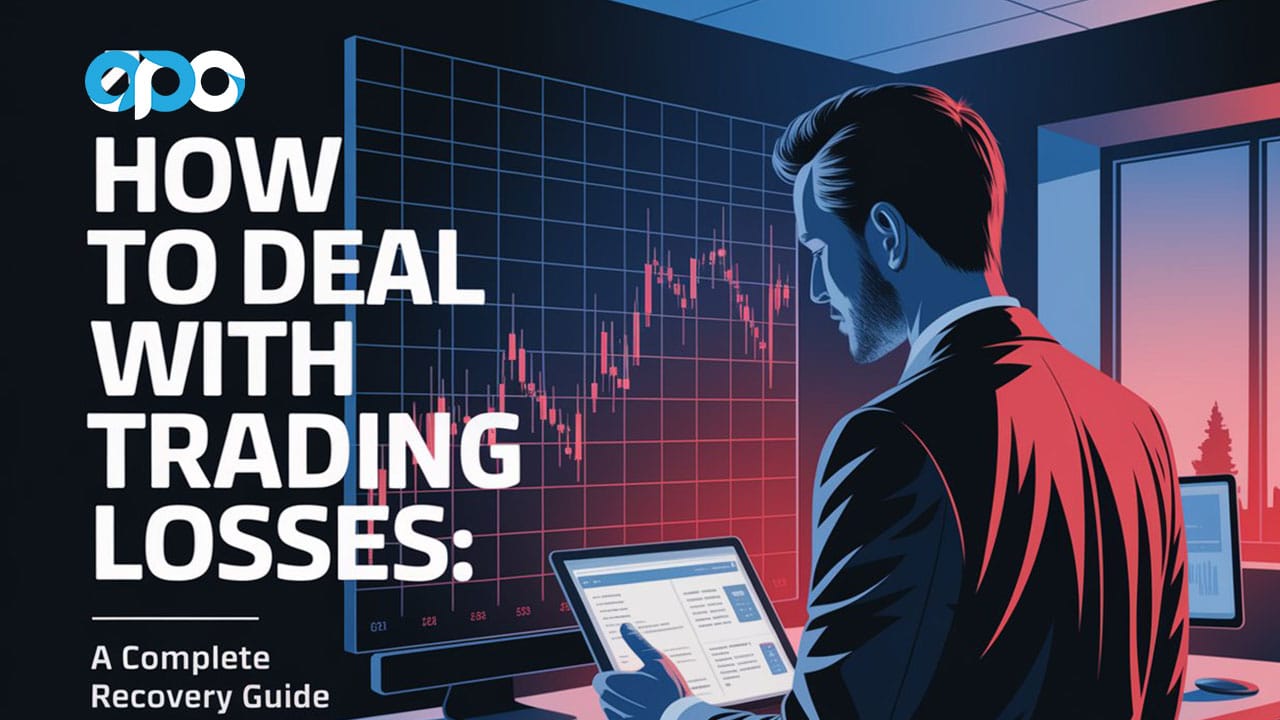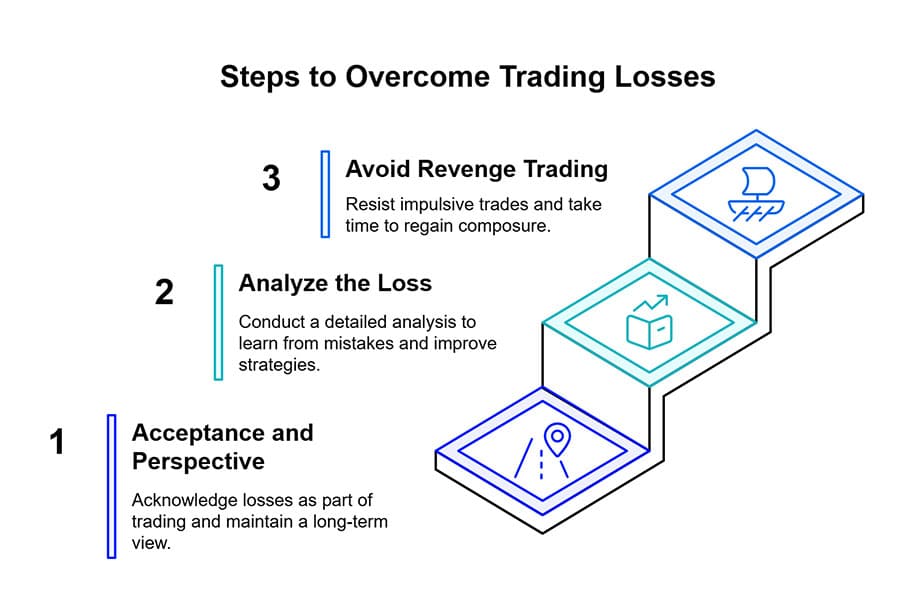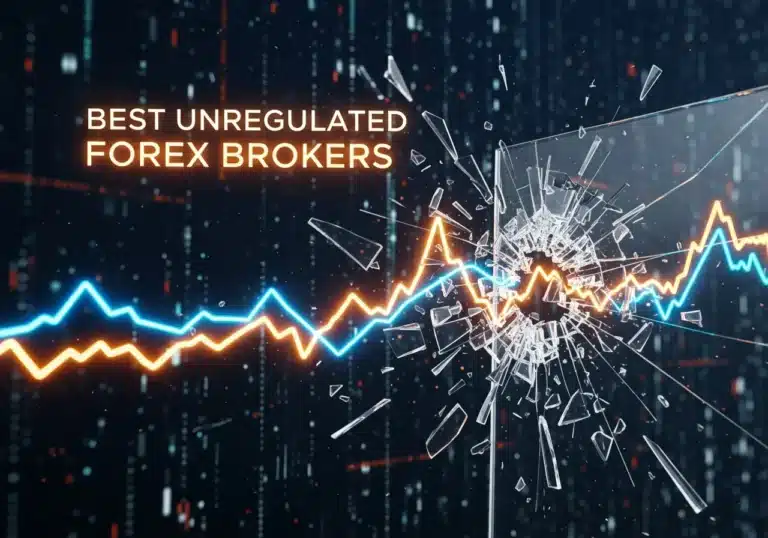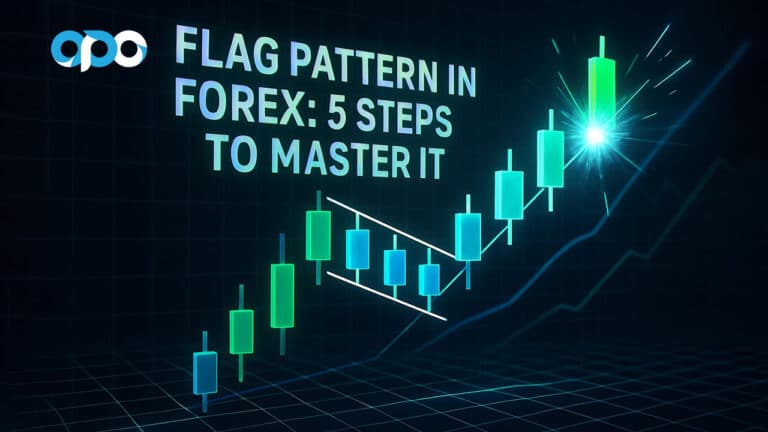The flashing red numbers on your trading screen. The sinking feeling in your stomach. The frustration that follows. If you’ve ever experienced trading losses, you know these sensations all too well. Whether you’re a novice trader or a seasoned professional working with a regulated forex broker, losses are an unavoidable aspect of trading in financial markets. Even the most successful traders experience setbacks – what distinguishes them is not the absence of losses but how effectively they manage and recover from them.

Trading losses are an inevitable part of the trading journey due to market unpredictability, volatility, and the inherent risk involved in any financial transaction. Learning how to deal with big trading losses is perhaps the most crucial skill that separates consistently profitable traders from those who eventually abandon the markets. This comprehensive guide will explore practical strategies, psychological techniques, and risk management principles that can help you navigate the emotional and financial challenges of trading losses.
Understanding Trading Losses
The unpredictable nature of financial markets makes trading losses inevitable. Markets are influenced by countless variables – economic indicators, geopolitical events, institutional fund flows, and even unforeseeable “black swan” events. No trader, regardless of experience or skill level, can anticipate every market movement with perfect accuracy.
According to trading psychology experts, accepting the probabilistic nature of trading is the first step toward managing losses effectively. Trading is not about being right all the time; it’s about having a positive expectancy over a series of trades. Even strategies with 60-70% win rates will experience periodic drawdowns and consecutive losses.
Psychological Impact of Trading Losses
Trading losses affect us on both financial and psychological levels. The psychological impact can be particularly severe, triggering a range of emotional and cognitive responses:
- Sustained losses can lead to heightened levels of stress and anxiety. Traders may experience worry and fear about their financial situation, their ability to succeed in trading, and the consequences of continued losses. This anxiety can manifest physically through insomnia, impaired memory, and difficulty concentrating.
- Many traders tie their self-worth to their trading success. Constant losses can erode self-esteem and lead to feelings of inadequacy or failure. This diminished self-confidence can create a negative cycle, further impairing trading decisions and exacerbating losses.
- Loss aversion causes individuals to feel the pain of losses more intensely than the pleasure of gains, leading to risk-averse behavior and reluctance to accept losses. This cognitive bias can cause traders to hold onto losing positions too long while taking profits too quickly – a recipe for poor long-term results.
Steps to Deal with Trading Losses

Acceptance and Perspective
The journey to recovery begins with acceptance. Acknowledging that losses are a natural part of trading – rather than anomalies or personal failures – creates the psychological space needed to respond constructively.
When how to deal with big trading losses is the question, you must ask yourself whether this loss was caused by not following your rules or by unforeseen market conditions. This critical distinction helps separate preventable mistakes from the inherent risks of trading.
Maintaining perspective is equally important. A single loss, or even a series of losses, doesn’t define your trading career or ability. Many successful traders have endured significant setbacks before achieving consistent profitability. Understanding that temporary setbacks don’t determine long-term outcomes allows you to move forward with clarity.
Analyze the Loss
Once you’ve accepted the loss and gained perspective, conducting a detailed post-trade analysis can transform a painful experience into a valuable learning opportunity. This analytical process helps identify specific mistakes, external factors, and potential improvements to your trading approach.
After any loss, regardless of how big or small, perform a post-trade analysis to understand what to do differently next time. Did you miss something in your research? Did you let emotions drive your decisions? Keeping a trade log or journal creates a valuable resource for identifying patterns and preventing similar losses in the future.
Consider tracking these elements in your analysis:
- Entry and exit points and their rationale
- Risk-reward ratio of the trade
- Market conditions at the time
- Emotional state during decision-making
- Adherence to trading plan and rules
- External factors that influenced the outcome
Avoid Revenge Trading
Perhaps the most dangerous response to trading losses is “revenge trading” – attempting to immediately recover losses through impulsive, emotionally-driven trades. This behavior often leads to abandoning established trading rules, taking excessive risks, and making decisions based on emotion rather than analysis.
When you experience a large trading loss, your cortisol (stress hormone) and adrenaline levels are high, leaving you chemically out of balance. Trading under these conditions is never a good idea as your mind is simply not clear. Time away from the screen is the best antidote to prevent deeper losses.
If the loss wipes out your daily average gains, you can statistically make that back in a day. A break of a few hours might be sufficient. However, if the loss eliminates more than a week’s gain, consider taking the remainder of the day off or even the next day too. When you restart trading, begin with smaller positions to rebuild confidence gradually.
Psychological Strategies for Coping with Losses

Emotional Control
Mastering emotional responses to trading losses is essential for maintaining sound judgment and decision-making abilities. Several evidence-based techniques can help traders manage emotions effectively:
- Developing mental resilience and discipline in the face of market swings is crucial for long-term success. Mindfulness techniques can help you stay focused and make better decisions despite the emotional turmoil that often accompanies losses.
- Utilize trading journals to reflect on every trade, not just the winners. This practice helps process emotions constructively and identify triggers that lead to poor decisions. Consider maintaining separate entries for the technical aspects of trades and the emotional experiences that accompanied them.
- Separating emotions from trading decisions by taking breaks when necessary is another powerful strategy. These intentional pauses create space for your emotional state to stabilize before making further trading decisions.
Building Resilience
Resilience – the ability to recover quickly from difficulties – is particularly valuable for traders. Building trading resilience involves:
- Developing a growth mindset allows you to view losses as learning opportunities rather than personal failures. Traders with growth mindsets see setbacks as temporary and addressable through effort and strategy adjustment.
- Setbacks are not failures but opportunities for growth and refinement. By approaching losses with curiosity rather than judgment, you transform painful experiences into valuable lessons that strengthen your trading approach.
- Creating support systems by connecting with other traders who understand the unique challenges of the profession provides emotional support and perspective during difficult periods. Trading communities, forums, and mentorship relationships can be invaluable sources of encouragement and advice.
Practical Recovery Strategies

Develop a Clear Plan
A robust trading plan acts as both a prevention and recovery tool for dealing with losses. Key components include:
- Establish a trading plan with set rules and guidelines, and practice disciplined trading according to your plan. This structure provides clarity during emotionally challenging periods and prevents impulsive decisions.
- Predefined entry and exit criteria remove ambiguity and reduce emotional decision-making during market fluctuations. Clear risk-reward ratios for each trade ensure that potential profits justify the risks taken.
- After experiencing significant losses, revisit your trading plan to identify potential improvements. Were there warning signs you missed? Could different risk management strategies have minimized the damage? Use these insights to strengthen your approach moving forward.
Start Small When Rebuilding Confidence
Recovering from significant losses often requires rebuilding trading confidence gradually. Consider these approaches:
- You might be tempted to jump back in with both feet, but consider taking on smaller positions than you’re used to. For example, if under normal circumstances you never risk more than 5% of your trading portfolio on a single trade, after a big loss you might reduce that to 2% or 3% until you feel you’re on solid ground.
- When you start trading again after a significant loss, trade small. Get back in the game slowly to rebuild your confidence and restore your psychological balance. Focus on high-probability setups and trades that align perfectly with your strategy to create positive reinforcement.
- Scale up and scale down your position sizes based on recent performance and confidence levels. This adaptive approach allows you to increase exposure gradually as you rebuild momentum while maintaining protection against further substantial losses.
Risk Management as Prevention

Position Sizing and Stop-Loss Orders
Effective risk management transforms how to deal with trading losses impacts your account and psychology. Two fundamental components are position sizing and stop-loss orders:
- The stop-loss order is one of the most powerful tools for managing losses. It automatically closes a trade once the price reaches a predetermined level, limiting your downside risk. Using stop-loss orders removes the emotional component from the decision to exit losing trades.
- The 1% rule ensures that no single trade risks more than 1% of your account balance. This conservative approach protects your capital from significant losses while allowing you to stay in the game. More conservative traders might use even lower percentages during volatile market conditions or when testing new strategies.
- Determine the maximum acceptable loss per trade and implement a maximum daily loss threshold. These predefined limits create a safety net that prevents catastrophic losses and forces a reassessment of your approach when predetermined thresholds are reached.
Diversification and Capital Allocation
Sophisticated risk management extends beyond individual trade protection to portfolio-level considerations:
- Diversify your trades to avoid putting all your capital into a single trade or currency pair. Diversification reduces the impact of losses by spreading risk across multiple assets. Trading across multiple asset classes can further reduce your exposure to sector-specific risks.
- Identify and trade multiple asset classes and implement correlation analysis to manage risk effectively. Understanding how different markets relate to each other helps create truly diversified exposure rather than just the illusion of diversification.
- Allocate a specific portion of capital to each strategy and schedule regular portfolio reviews to adjust allocations. This disciplined approach ensures that no single approach dominates your trading activities and creates resilience against changing market conditions.
Seeking Support and Guidance

Peer Support and Mentorship
Trading can be an isolating endeavor, particularly during difficult periods. Creating connections with fellow traders provides valuable perspective and emotional support:
- Seek feedback from a trading mentor or peer group who can offer objective insights about your trading approach. These outside perspectives often identify blind spots in your analysis or emotional patterns that might not be apparent to you.
- Participating in simulations and educational activities with other traders improves decision-making skills in a low-risk environment. These collaborative learning experiences create community while simultaneously building technical skills.
- Consider joining trading communities specifically focused on psychological resilience and recovery from losses. These specialized groups provide targeted support during challenging periods and practical strategies for rebuilding confidence.
Professional Help if Needed
When trading losses lead to persistent emotional distress, seeking professional support may be appropriate:
- For traders experiencing symptoms of anxiety, depression, or other significant psychological distress, working with therapists or counselors provides evidence-based approaches for managing these conditions. The psychological impact of constant losses can sometimes extend beyond what peer support alone can address.
- Financial advisors can help ensure trading activities remain aligned with broader financial goals and that risk exposure is appropriate for your overall financial situation. This professional perspective helps contextualize trading within your complete financial picture.
- Recognizing when to seek help is itself a valuable skill. Persistent sleep disturbances, relationship problems, concentration difficulties, or thoughts of self-harm are signs that professional support is warranted. Trading success ultimately depends on mental wellbeing, making appropriate care an investment in your trading future.
Moving Forward After a Loss

Focus on Long-Term Goals Over Short-Term Setbacks
Maintaining focus on long-term trading objectives provides context for individual losses and motivation during recovery periods:
- Revisit your trading purpose and reconnect with your fundamental reasons for trading – financial independence, intellectual challenge, or career development – to regain perspective after setbacks.
- Establish process goals related to trading behaviors rather than outcomes (e.g., perfect execution of your strategy, maintaining emotional discipline) to create achievable targets during recovery periods. These process-oriented metrics provide a sense of control and progress even when markets remain challenging.
- Evaluate overall trading strategy periodically for psychological impact and sustainability. A strategy that generates constant emotional strain may not be sustainable regardless of its theoretical profit potential. Finding approaches that align with your psychological makeup creates resilience during difficult periods.
Regular Self-Care Practices
Physical and mental well-being significantly influence trading performance, particularly during challenging periods:
- Incorporate stress management techniques into your routine to maintain emotional balance. Regular exercise, meditation, deep breathing exercises, and adequate sleep all contribute to cognitive clarity and emotional stability.
- Separate emotions from trading decisions by taking breaks when necessary. Even brief periods away from the screens can restore perspective and prevent emotionally-driven errors from compounding existing losses.
- Maintain interests and relationships outside of trading to provide perspective and emotional fulfillment that buffers against trading-related stress. A well-rounded life creates resilience that supports recovery from trading setbacks.
Pro Tips for Advanced Traders
Experienced traders can implement these advanced strategies for dealing with trading losses:
- Implement Adaptive Risk Management
Advanced traders should consider volatility-adjusted position sizing that tailors position sizes to account for current market volatility. This approach automatically reduces exposure during turbulent periods and increases it during more stable conditions.
- Utilize correlation analysis
Utilize correlation analysis to understand how your various positions relate to each other, ensuring genuine diversification rather than illusory risk spreading. This sophisticated approach identifies hidden concentrations of risk that might not be apparent when viewing positions individually.
- Develop Psychological Circuit Breakers
Establish predefined criteria for temporary trading cessation based on psychological indicators rather than just financial metrics. These personal “circuit breakers” might include sleep quality thresholds, stress measurements, or emotional state assessments that, when triggered, mandate a trading pause.
- Use biometric feedback devices
Use biometric feedback devices to track physiological stress responses during trading, identifying potential emotional decision-making before it affects trade execution. Heart rate variability, skin conductance, and other measurements provide objective data about your emotional state.
- Create Counter-Cyclical Strategies
Maintain alternative trading approaches that typically perform well in conditions where your primary strategy struggles, creating natural hedges against strategy-specific losses. These complementary approaches provide trading opportunities even during challenging periods for your main strategy.
- Develop a “recovery mode” trading plan
Develop a “recovery mode” trading plan with pre-established parameters for rebuilding after significant losses. This specialized approach might include reduced position sizes, higher-probability setups, and more conservative targets until confidence and capital are restored.
Opofinance Services Section
Advanced Trading Solutions with ASIC-Regulated Broker Opofinance
When dealing with trading losses, having the right broker with robust tools and support can make all the difference in your recovery journey. Opofinance, an ASIC-regulated broker, offers comprehensive solutions designed to help traders navigate markets effectively:
- Premium Trading Platforms – Access markets through industry-leading MT4, MT5, cTrader, and the proprietary OpoTrade platform, each offering advanced analytical tools crucial for post-loss analysis
- Innovative AI Trading Tools – Leverage cutting-edge AI Market Analyzer to identify new opportunities, receive personalized guidance from AI Coach during recovery phases, and access immediate assistance through AI Support
- Social & Prop Trading Options – Learn from successful traders and diversify your approach through social trading features that can be particularly valuable when rebuilding confidence
- Secure & Flexible Transactions – Enjoy peace of mind with safe deposit and withdrawal methods including cryptocurrency options, all with zero fees from Opofinance
- Comprehensive Educational Resources – Access training materials specifically designed to help traders develop resilience and effective risk management strategies

Ready to transform your approach to trading losses with professional-grade tools and support? Visit Opofinance.com today to discover how their advanced trading ecosystem can support your trading recovery and growth.
Conclusion
How to deal with trading losses is perhaps the most crucial skill that separates successful traders from those who eventually exit the markets. Losses are not just financial setbacks but valuable learning opportunities that, when approached correctly, strengthen your trading methodology and psychological resilience.
The journey through trading losses begins with acceptance and perspective, followed by thoughtful analysis that transforms painful experiences into powerful lessons. Effective risk management practices like proper position sizing, stop-loss implementation, and portfolio diversification serve as both prevention and recovery tools, limiting the severity of inevitable drawdowns.
The psychological dimension of trading losses cannot be overlooked. Developing emotional control through mindfulness, journaling, and cognitive restructuring creates the mental conditions necessary for sound decision-making even after significant setbacks. Building resilience by separating self-worth from trading outcomes and maintaining support networks provides the psychological foundation for long-term trading success.
Remember that every successful trader has experienced losses – often substantial ones – on their path to profitability. What distinguishes those who ultimately succeed is not the absence of losses but how effectively they respond to them. By implementing the strategies outlined in this guide, you can transform trading losses from discouraging setbacks into stepping stones toward greater trading mastery.
Key Takeaways
- Trading losses are inevitable due to market unpredictability; accepting this reality is the first step toward effective management
- Post-loss analysis transforms setbacks into valuable learning opportunities that strengthen future trading
- Avoiding revenge trading through mandatory cooling-off periods prevents compounding losses with emotional decisions
- Psychological techniques like mindfulness, journaling, and cognitive restructuring help maintain emotional balance after losses
- Gradually rebuilding confidence through reduced position sizes and focusing on high-probability setups creates sustainable recovery
- Robust risk management through position sizing, stop-loss orders, and diversification minimizes the impact of individual losses
- Seeking support from trading communities, mentors, or professionals provides valuable perspective during challenging periods
- Maintaining physical and mental well-being through self-care practices creates the foundation for resilient trading psychology
How do large trading losses affect long-term trading psychology?
Large trading losses can create lasting psychological impacts beyond their immediate financial consequences. Traders may develop loss aversion, becoming overly cautious and missing profitable opportunities. Others might experience “trading PTSD,” where similar market conditions trigger anxiety and impaired decision-making. The key to preventing long-term psychological damage is processing losses thoroughly, seeking support when needed, and gradually rebuilding confidence through controlled exposure to markets. Many professional traders report that properly processed significant losses actually strengthened their trading psychology by forcing improvement in risk management and emotional regulation.
When should a trader consider changing their strategy versus persisting through a losing streak?
This critical question requires balancing persistence with adaptability. Consider changing your strategy when: 1) Statistical analysis shows performance deterioration beyond normal variance; 2) Market structure has fundamentally changed (e.g., volatility regimes, regulatory changes); 3) Your edge has been neutralized by wider adoption; or 4) The strategy consistently underperforms across various market conditions. Conversely, persist when: 1) Losses fall within expected statistical parameters; 2) The strategy previously performed well in similar market conditions; 3) Recent losses can be attributed to specific, non-recurring events; or 4) Minor refinements rather than wholesale changes address identified issues. Regular strategy performance reviews using objective metrics help make this determination less emotional and more data-driven.
How can traders effectively manage family and relationship stress caused by significant trading losses?
Trading losses often spill over into personal relationships, creating additional pressure during already stressful periods. Effective management includes: 1) Transparent communication with family members about trading risks and potential outcomes before significant losses occur; 2) Establishing clear boundaries between trading activity and family life; 3) Developing a “financial firewall” that protects essential family resources from trading capital; 4) Creating shared understanding about the recovery process and realistic timelines; and 5) Considering family counseling when trading-related stress significantly impacts relationships. Including trusted family members in appropriate aspects of your recovery plan can transform potential relationship strain into valuable support during challenging periods.







